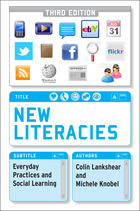Saturday, November 13, 2004
I finally get it.
It's taken a while for the penny to drop, but I finally understand a key factor behind the current push to 'accredit' teacher education institutions in the US by having them demonstrate their students meet a set of handed-down standards. It ain’t about producing theory-savvy, smart teachers who are able to tailor their literacy teaching in ways that maximizes all students’ learning and life chances. It's really about making
Over the past 18 months a good friend and colleague of mine and I have been struggling with developing an assignment that would enable Masters-level students in a foundational introduction-to-literacy course to demonstrate their understandings of the effects different theories have on classroom literacy teaching. The standards we needed to aim at were developed by the International Reading Association. There are 5 'Standards for Reading Professionals' (yes, warning bells rang long ago on this alone—no attempt on their part to even pretend literacy was on the agenda), and each has at least 3-4 sub-indicators. The particular standards we were targetting in the foundation course are Standards 1.1 and 1.2 in the following set:
Standard 1: Foundational knowledge
Now, part of the trouble we ran into is that not all the students who enroll in our foundational literacy course are going to be "Reading Specialists" (some are already teachers, some are becoming teachers. Some are focusing on primary school teaching, others are focusing on secondary school teaching). We needed to construct an assignment that would make sense in terms of being a worthwhile activity for students, but that also engaged seriously with the three sets of theories identified by the International Reading Association (and which we rewrote anyway as: psychological theories, humanist theories and sociocultural theories because the categories decided upon by the IRA simply aren’t a good fit for the field of literacy education; we also ignored the distinct differences between theories of literacy and theories of literacy instruction which don't always neatly coincide because the IRA was clearly ignoring the distinctions itself).
So my colleague, Peggy, and I struggled with coming up with something that would sufficiently demonstrate theoretical understandings without being so esoteric that we’d have a student revolt on our hands. In frustration, I emailed IRA and asked them to send sample assignments that they felt adequately addressed this first standard. Here is the email exchange that then took place.
Dear (name removed)--
Our literacy faculty at Montclair State University has been trialling an assignment designed to meet the first standard for the 2003 version of the IRA standards: Foundational Knowledge.
We are currently trialling an essay that asks students to analyze one of three classroom case studies in terms of the three families of theories identified in Standard 1.1, and to locate these theoretical orientations and their impact on pedagogy historically (standard 1.2). The cases themselves are complex and require students to comment on cultural and linguistic diversity.
The problem that we're running into is that the essay task is both theoretically and analytically complex, especially within a class where the majority of students are not enrolled in our Master of Arts in Reading or Reading Specialist certificate programs. We are working on ways of making the present assignment more manageable for students and are keen to know if you are able to supply us with models of assignments other teacher education faculties have developed to meet Standard 1 using the 2003 Standards and which we could use to guide our reflections on, and our revisions of, this particular assignment.
With thanks,
Michele
Hi Michele,
While we don't have examples such as you may be interested in, I can give you copies of a child study assignment and rubric and how they relate to the standards. I have attached them. You should also be aware of a new resource "Preparing Reading Professionals: A Collection From the International Reading Association". This publication offers the scientific research behind the standards.
You can find information about this publication on our website www.reading.org or directly at http://marketplace.reading.org/products/tnt_products.cfm?Subsystem=ORD&primary_id=564&product_class=IRABOOK&action=Long
I hope this information is helpful.
(name removed)
I was rather nonplussed at the reference to the IRA textbook, because I hadn't asked at all about academic reading materials because Peggy and I have spent many hours putting together a selection we feel covers a satisfyingly wide spectrum of theoretical positions within current literacy education. All I wanted to know was how other people were ensuring that they demonstrated Standards 1.1 and 1.2 were met by students within their teacher education literacy courses. My initial bewilderment quickly turned into annoyance when I examined the contents page and found the book to be rather limited in theoretical scope overall (it does have some gems in it, but overall the literacy-related theories addressed certainly aren’t sufficient).
This annoyance subsequently turned into disbelief when I read the sample assignment. It was a case analysis of a child, and the assignment descriptions pertinent to IRA Standard 1 read as follows:
Reading analysis (IRA 1.1, 1.2, 1.3, 3.2)
Use Holdaway’s levels of reading to determine the child’s reading development. These levels can be found in chapter 6. Use your Fox text to assist you in determining the level of phonics development the child is showing. Using Marie Clay's Concepts About Print that was discussed in class, indicate what concepts are known to the child. If the child is still focused on developing phonemic awareness, use the assessments in the Ericson, & Juliebo text to determine exactly what they know phonemically. You are encouraged to look into other researchers. Researchers may be Lesley Morrow, Dorothy Strickland, Connie Juel, Yetta Goodman, Emilia Ferreiro, and Marie Clay. Did you see growth over the semester? Justify all your answers by linking to the child's work.
Writing and Spelling Analysis: (IRA 1.1, 1.2, 1.3, 3.2)
Over a period of five weeks, collect six – seven writing samples of your child and analyze their writing and spelling development using the research of Richard Gentry that we covered in class. Researchers you may want to examine, but are not limited to are: Marie Clay, Richard Gentry, Susan Sowers, Yetta Goodman, Emilia Ferreiro, Edmond Henderson, Charles Read, and Charles Temple. Determine the child's stage of spelling development. What does the writing and spelling samples tell you about the child's phonological awareness and phonics knowledge? What stage of spelling development is the child presently at? Did you see growth over the semester. Justify all your answers by linking to the child's work.
Maybe I’m missing something, but I would never claim that this assignment enables faculty to collect data pertaining to Standards 1.1, 1.2 and 1.3 (partially yes, but certainly not completely by any stretch of the imagination).
So I emailed IRA again, just to be sure (because I also set a case study assignment within my foundation class and simply couldn't see how it could possibly be used to demonstrate theoretical knowledge across all three target families of theories). Here’s what they said.
Hi Michele,
Yes, this example does address standard 1. I didn't notice however if it addressed element 1.4. You get the idea however. Again, the publication, Preparing Reading Professionals . . . . (a collection of previously published works) complements the IRA standards and is set up so it covers each element of each standard.
(name removed)
That's when the penny finally dropped (I can be so naïve at times). It doesn’t matter one jot what the assignment is, if you assign Preparing Reading Professionals as your set text then clearly you've met the 'knowledge' standards for IRA. So now, let me do some maths: we run three sections of this course twice a year at 30 or more students a section, plus at least one summer version of the course for another 30 or so students, which adds up to around 210 students a year. At $32.95 a pop for the textbook, the IRA would stand to make a tidy sum just from our institution alone.
Needless to say, we are not setting the text.
And we are sticking with our current assignment that does have students engage seriously with theories of literacy and literacy instruction.
There is something very BIG BROTHER about all of this where scope to think beyond the box is very difficult.
I have found it very hard in the UK to come up with a happy solution to satisfying standards set by the Teacher Training Agency, the National Curriculum people and the new National Literacy Strategy. All three of these conflict with each other and the Teacher Training Agency conflicts with the Offfice for Standards in Education Inspectorate. This added to the fact that my own priorities differ from all of these agencies have made it hard for me in Initial Teacher Education over the last few years - and happily I am now out of it.
The National Literacy Strategy produces publication after publication with which it bombards schools and Initial Teacher Education establishments all the time. Whilst these publications are all free of charge, they are worth a lot of money that personally I think could be much better spent and they have become compulsory fare for teachers in state schools throughout England. (And someone somewhere is clearly profiting).We have had to use the publications a lot in our teaching sessions which have therefore become very content driven. There is no emphasis at all in motivating teachers to think about theoretical concepts at all. And this is very scarey as a technicist approach to teaching has become stronger every year that I have been involved in teacher education.
<< Home









